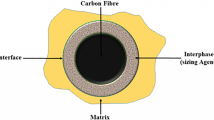The effect of silicon carbide (10 – 40 wt.%) on the physicomechanical and electrophysical characteristics of composites was considered. The effect of an additive on the radio absorption capacity of the material was determined by measuring the coefficients of absorption, transmission, and reflection of electromagnetic radiation as well as the dielectric constant of the material. It was found that introducing 30 wt.% silicon carbide into the composition increases the strength in compression to 2.4 MPa due to the reinforcing role of silicon carbide needle crystals. The additional dielectric losses and the average pore size of the composite on introduction of 30% silicon carbide afford an absorption coefficient of electromagnetic radiation from 95 to 98% in the frequency range 120 – 250 GHz. The results of this work expand the areas of application of porous glass composites as well as the raw material base for obtaining the material.





Similar content being viewed by others
References
M. A. K. Askerova, T. R. O. Tarverdiev, and A. G. O. Abdullaev, “Sources of electromagnetic radiation and their negative impact on human health,” Europaische Fachhochschule, No. 1, 39 – 41 (2016).
L. N. Zvyagina, N. V. Mozgovoi, V. V. Efremov, “Electromagnetic safety of urban residents,” Inform. Tekhnol. Stroit., Sots. Ekon. Sist., No. 1(19), 125 – 128 (2020).
M. V. Dyadenko and A. I. Gelai, “Radiotransparent materials based on titanosilicate glasses,” Glass Ceram., No. 8, 15 – 20 (2017) [Steklo Keram., No. 8, 15 – 20 (2017)]
G. A. Nikolaichuk, “Experience of development and application prospects of wide-range radio-absorbing materials for groundbased equipment,” in: Actual Problems of Protection and Safety: Proc. 22nd All-Russian Scientific and Practical Conf. RARAN, St. Petersburg, April 1 – 4, 2019 [in Russian], St. Petersburg (2019), pp. 119 – 125.
A. Delfini, M. Albano, and A. Vricella, “Advanced radar-absorbing ceramic-based materials for multifunctional applications in space environment,” ResearchGate: Materials, No. 11(9) (2018).
S. Seckin, “Dielectric properties of low-loss polymers formmW and THz applications,” J. of Infrared, Millimeter, and Terahertz Waves, 40, 557 – 573 (2019).
L. Dong, Z. Binzhen, and D. Junping, “Conformal transparent metamaterials inducing ultra-broadband absorption and polarization conversion,” J. of Infrared, Millimeter, and Terahertz Waves, 40, 905 – 916 (2019).
A. P. Savel’ev, A. N. Skvortsov, S. A. Enaleeva, and S. V. Glotov, “Application of honeycomb and cellular structures for noise protection at processing industry enterprises of the agro-industrial complex,” Vest. Mordovskogo Univ., 27(2), 215 – 223 (2017).
D. E. F. Vergara, B. H. K. Lopesa, and S. F. Quirino, “Frequency selective surface properties of microwave new absorbing porous carbon materials embedded in epoxy resin,” Mater. Res., 22 (2019), Suppl. 1.
O. Kazmina, M. Dushkina, and V. Suslyaev, “Porous material for protection from electromagnetic radiation,” in: Intern. Conf. on Physical Mesomechanics of Multilevel Systems 2014, AIP Conf. Proc. (2014), Vol. 1623, pp. 241 – 244.
P. Bollen, N. Quievy, and C. Detrembleur, “Processing of a new class of multifunctional hybrid for electromagnetic absorption based on a foam filled honeycomb,” Mater. Design, 89, 323 – 334 (2016).
M. González, M. Crespo, and J. Baselga, “Carbon nanotube scaffolds with controlled porosity as electromagnetic absorbing materials in the gigahertz range,” Nanoscale, No. 8(20), 10,724 – 10,730 (2016).
V. N. Startsev, Radioelectronic Module with a Hidden Polycrystalline Ferrite Marking, Pat. RU 176967 U1 [in Russian], declared 03/06/2017; published 02/05/2018.
K. L. Devin, A. S. Agafonova, and I. I. Sokolov, “Prospects for the use of radio-absorbing materials to ensure electromagnetic compatibility of airborne radio-electronic equipment,” Zashch. Funkts. Pokrytiya, Tr. VIAM, No. 8(90), 94 – 100 (2020).
L. Chenyu, Y. Dawei, W. K. Donald, and X. Yongjun, “Electromagnetic wave absorption of silicon carbide based materials,” RSC Adv., No. 2, 595 – 605 (2017).
H. Zhang, J. Zhang, and H. Zhang, “Computation of radar absorbing silicon carbide foams and their silica matrix composites,” Comput. Mater. Sci., 38(4), 857 – 864 (2007).
L. Wan-Chong, L. Chu-Sen, L. Li-Hai, et al., “The electromagnetic wave absorbing properties of the silicon carbide/carbon foam material based on tetrakaidecahedron model,” Mater. Res. Express, 5(11) (2018).
V. I. Semenova, V. A. Kutugin, and O. V. Kaz’mina, “Synthesis and properties of silicon-carbide-modified porous glass composite,” Glass Ceram., 77(3 – 4), 127 – 134 (2020) [Steklo Keram., No. 4, 10 – 18 (2020)].
This Russian Foundation for Basic Research funded this research as part of scientific project No. 19-33-90099.
Author information
Authors and Affiliations
Corresponding author
Additional information
Translated from Steklo i Keramika, No. 4, pp. 9 – 15, April, 2021.
Rights and permissions
About this article
Cite this article
Semenova, V.I., Kaz’mina, O.V., Dorozhkin, K.V. et al. Physical, Mechanical, and Electrophysical Properties of Porous Glass Composite with Silicon Carbide Additives. Glass Ceram 78, 140–144 (2021). https://doi.org/10.1007/s10717-021-00364-2
Published:
Issue Date:
DOI: https://doi.org/10.1007/s10717-021-00364-2




